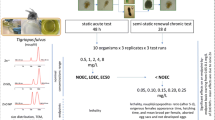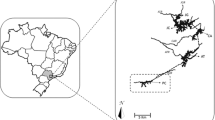Abstract
The effects of Zn on two mysid, two copepod, and one decapod crustacean species from Peter the Great Bay are studied. Experiments have shown the lowest median lethal concentrations (LC50) in the case of a 48-h exposure for juvenile mysids (221 μg Zn2+/L) and the highest concentrations for juvenile grass shrimp (11 309 μg Zn2+/L). The relationship of toxicoresistance with species-specific features, body size, and the ontogeny stage of test organisms, as well as with experimental conditions, including water temperature, has been confirmed.
Similar content being viewed by others
REFERENCES
Dolganova, N.T., Zooplankton in the Japan Sea as a potential forage base for salmons pasturing, Izv. Tikhookean. Nauchno-Issled.Inst. Rybn. Khoz. Okeanogr., 2010, vol. 163, pp. 311–337.
Metodicheskiye ukazaniya po razrabotke normativov kachestva vody vodnykh ob’’ektov rybokhozyaistvennogo znacheniya, v tom chisle normativov predel’no dopustimykh kontsentratsii vrednykh veshchestv v vodakh vodnykh ob’’ektov rybokhozyaistvennogo znacheniya (Guidelines for the Development of the Water Quality Standards for Water Bodies Significant for Fisheries, Including Standards for Maximum Permissible Concentrations of Harmful Substances in Water Bodies Significant for Fisheries), Moscow: VNIRO, 2011.
Moore, J.W. and Ramamoorthy, S., Heavy Metals in Natural Waters: Applied Monitoring and Impact Assessment, New York: Springer, 1984.
Naumov, Yu.A., The anthropogenic impact on the coastal shelf zone of Russia’s Far-Eastern seas (a case study of the Peter the Great Bay), Geogr. Prir. Resur., 2007, no. 1, pp. 106–114.
Pushchina, O.I., Feeding and food relations of mass bottom fishes in the waters of Primorye in spring, Izv. Tikhookean. Nauchno-Issled.Inst. Rybn. Khoz. Okeanogr., 2005, vol. 142, pp. 246–269.
Khristoforova, N.K., Shulkin, V.M., Kavun, V.Ya., and Chernova, E.N., Tyazhelye metally v promyslovykh i kul’tiviruemykh mollyuskakh zaliva Petra Velikogo (Heavy Metals in Commercial and Cultivated Mollusks from Peter the Great Bay), Vladivostok: Dal’nauka, 1993.
Chelomin, V.P., Bel’cheva, N.N., Slin’ko, E.N., and Silina, A.V., Characteristics of the trace element composition of benthic invertebrates exposed to terrigenous runoff and anthropogenic pressure, in Sostoyaniye morskikh ekosistem, nakhodyashchikhsya pod vliyaniem rechnogo stoka (Condition of Marine Ecosystems Exposed to River Runoff), Vladivostok: Dal’nauka, 2005, pp. 228–245.
Cherkashin, S.A., Nikiforov, M.V., and Shelekhov, V.A., The use of the mortality rate of marine fish prelarvae for the estimation of zinc and lead toxicity, Russ. J. Mar. Biol., 2004, vol. 30, no. 3, pp. 217–222.
Cherkashin, S.A., Pryazhevskaya, T.S., Kovekovdova, L.T., and Simokon’, M.V., Effect of copper on the survival of prelarvae of the Japanese anchovy Engraulis japonicus,Russ. J. Mar. Biol., 2008, vol. 34, no. 5, pp. 336–339. https://doi.org/10.1134/S106307400805012X
Cherkashin, S.A. and Blinova, N.K., The effect of heavy metals on the survival rate of crustaceans (a review), Gidrobiol. Zh., 2010, vol. 46, no. 4, pp. 84–97.
Ahsanullah, M., Negilski, D.S., and Mobley, M.C., Toxicity of zinc, cadmium, and copper, to the shrimp Callianassa australiensis. I. Effects of individual metals, Mar. Biol., 1981, vol. 64, pp. 299–304.
Aquatic Hazard Assessment II Databases, ECETOC Technical Report, no. 91. Brussels: Eur. Centre Ecotoxicol. Toxicol. Chemicals, 2003.
Arnott, G.H. and Ahsanullah, M., Acute toxicity of copper, cadmium and zinc to three species of marine copepod, Aust. J. Mar. Freshwater Res., 1979, vol. 30, no. 1, pp. 63–71.
Barbieri, E., Branco, J.O., Santos, M.C.F., and Hidalgo, K.R., Effects of cadmium and zinc on oxygen consumption and ammonia excretion of the sea-bob shrimp, according to the temperature, Bol. Inst. Pesca, 2013, vol. 39, no. 3, pp. 299–309.
Damasceno, É.P., de Figuerêdo, L.P., Pimentel, M.F., et al., Prediction of toxicity of zinc and nickel mixtures to Artemia sp. at various salinities: From additivity to antagonism, Ecotoxicol. Environ. Saf., 2017, vol. 142, pp. 322–329.
de Figuerêdo, L.P., Nilin, J., da Silva, A.Q., et al., Development of a short-term chronic toxicity test with a tropical mysid, Mar. Pollut. Bull., 2016, vol. 106, nos. 1–2, pp. 104–108.
Eisler, R., Zinc Hazards to Fish, Wildlife, and Invertebrates: A Synoptic Review, Contaminant Hazard Reviews, Report no. 26, Laurel, Md.: U.S. Dep. of the Interior, 1993, no. 10, pp. 5–106.
Henry, R.P., Lucu, Č., Onken, H., and Weihrauch, D., Multiple functions of the crustacean gill: osmotic/ionic regulation, acid-base balance, ammonia excretion, and bioaccumulation of toxic metals, Front. Physiol., 2012, vol. 3, art. ID 431. https://doi.org/10.3389/fphys.2012.00431
Holmstrup, M., Bindesbøl, A.-M., Oostingh, G.J., et al., Interactions between effects of environmental chemicals and natural stressors: A review, Sci. Total Environ., 2010, vol. 408, no. 18, pp. 3746–3762.
Hunt, J.W., Anderson, B.S., Turpen, S.L., et al., Interlaboratory Comparisons and Protocol Development with Four Marine Species, Marine Bioassay Project, Sixth Report, Sacramento, Calif.: State Water Resour. Control Board, 1991.
Janssen, C.R., Heijerick, D.G., De Schamphelaere, K.A.C., and Allen, H.E., Environmental risk assessment of metals: tools for incorporating bioavailability, Environ. Int., 2003, vol. 28, no. 8, pp. 793–800.
Min, E.Y., Kim, Y.S., Kim, S.S., et al., Acute toxicity of various heavy metals on mysid, Neomysis japonica,Korean J. Fish. Aquat. Sci., 2009, vol. 42, no. 6, pp. 628–632.
McLusky, D.S. and Hagerman, L., The toxicity of chromium, nickel and zinc: effects of salinity and temperature, and the osmoregulatory consequences in the mysid Praunus flexuosus,Aquat. Toxicol., 1987, vol. 10, no. 4, pp. 225–238.
Nipper, M.G., Badaré-Pedroso, C., José, V.F., and Melo, S.L.R., Toxicity testing with coastal species of Southeastern Brazil. Mysids and copepods, Bull. Environ. Contam. Toxicol., 1993, vol. 51, pp. 99–106.
Nipper, M.G. and Williams, E.K., Culturing and toxicity testing with the New Zealand mysid Tenagomysis novae-zealandiae, with a summary of toxicological research in this group, Australas. J. Ecotoxicol., 1997, vol. 3, pp. 117–129.
Verslycke, T., Vangheluwe, M., Heijerick, D., et al., The toxicity of metal mixtures to the estuarine mysid Neomysis integer (Crustacea: Mysidacea) under changing salinity, Aquat. Toxicol., 2003, vol. 64, no. 3, pp. 307–315.
Voie, Ø. and Mariussen, E., Effects of Heavy Metals from Outdoor Shooting Ranges on Aquatic Organisms, FFI-Rapport 2010/00680, Kjeller, Norway: Norwegian Defence Research Establishment, 2010, vol. 680.
Wang, Z., Kwok, K.W.H, Lui, G.C.S., et al., The difference between temperate and tropical saltwater species’ acute sensitivity to chemicals is relatively small, Chemosphere, 2014, vol. 105, pp. 31–43.
Wright, D.A., Trace metal and major ion interactions in aquatic animals, Mar. Pollut. Bull., 1995, vol. 31, pp. 8–18.
Wu, J.P. and Chen, H.-C., Effects of cadmium and zinc on oxygen consumption, ammonium excretion, and osmoregulation of white shrimp (Litopenaeus vannamei), Chemosphere, 2004, vol. 57, no. 11, pp. 1591–1598.
Zhang, C., Yu, K., Li, F., and Xiang, J., Acute toxic effects of zinc and mercury on survival, standard metabolism, and metal accumulation in juvenile ridgetail white prawn, Exopalaemon carinicauda,Ecotoxicol. Environ. Saf., 2017, vol. 145, pp. 549–556.
ACKNOWLEDGMENTS
The author is grateful to L.T. Kovekovdova, Dr. Sci. Biol., and M.V. Simokon, Cand. Sci. Biol., the head of the Analytical Center, Pacific Research Fisheries Center, for measuring Zn2+ in tested solutions.
Author information
Authors and Affiliations
Corresponding author
Ethics declarations
Conflict of interests. The author declares that he has no conflict of interest.
Statement on the welfare of animals. All applicable international, national, and/or institutional guidelines for the care and use of animals were followed.
Additional information
Translated by E. Shvetsov
Rights and permissions
About this article
Cite this article
Cherkashin, S.A. The Effect of Zinc on Survivability of Some Mysid, Decapod, and Copepod Species from Peter the Great Bay, Sea of Japan. Russ J Mar Biol 46, 215–220 (2020). https://doi.org/10.1134/S1063074020030037
Received:
Revised:
Accepted:
Published:
Issue Date:
DOI: https://doi.org/10.1134/S1063074020030037




